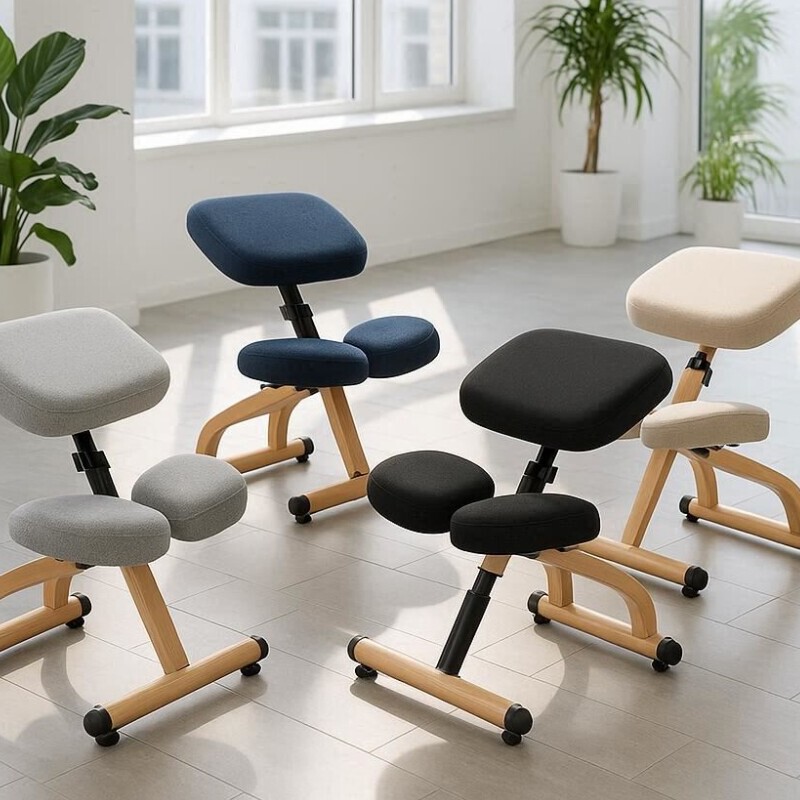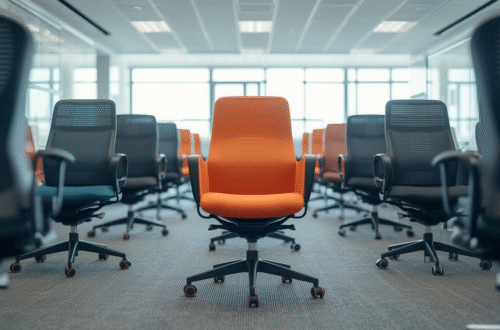Sitting at a desk for long hours can get pretty uncomfortable, and plenty of us start searching for ways to beat those aches and tired muscles. That’s probably why stools and kneeling chairs have gotten so much attention in the world of ergonomic seating. I find both of these options popping up in homes and offices where people want something a little different from the regular desk chair experience. But stools and kneeling chairs: are they ergonomic?
Here’s my deep-dive on stools and kneeling chairs, what works, what doesn’t, and how to figure out if one might help you stay comfortable at your desk.

Understanding Stools and Kneeling Chairs
Stools and kneeling chairs might look super simple compared to traditional office chairs, but the way they support your body is actually a little more complex. The main idea behind both is to change up your posture, activate new muscle groups, and stay a bit more mobile even while sitting.
While stools are known for their straightforward design, kneeling chairs are recognized for encouraging a different alignment of the spine and hips.
Stools usually have no backrest and sometimes adjust up and down. Some wobble or tilt, designed to keep your core muscles firing to hold you steady.
Kneeling chairs swap out the usual seat setup for a sloped seat and knee pads, nudging your hips forward and taking some pressure off your spine by spreading your weight between your butt and shins. This configuration is intended to help people avoid the slouch that creeps in with many standard office chairs.
Are Kneeling Chairs Ergonomic?
Kneeling chairs are often sold as a fix for slouching and back pain, but whether they count as ergonomic depends a lot on how you use them and your body type. In my experience, the unique setup of a kneeling chair can encourage an upright posture.
It tilts your pelvis forward just a bit, which gives your lower back its natural curve, something regular chairs often don’t help with. Keeping your spine in this neutral position can provide comfort throughout the workday for some users.
I’ve seen research and user reports that kneeling chairs can sometimes reduce lower back discomfort, especially for folks who find themselves slumping or hunching over their desks.
The National Library of Medicine has even reported that kneeling chairs can encourage more open hip angles, which can feel a lot better if stiff hips are a problem for you (source).
You’ll want to watch out for using a kneeling chair all day long, though. Most ergonomics experts recommend switching it up, using a kneeling chair for a few hours, then a regular chair for the rest, to give your knees and shins a break.
In short, kneeling chairs can be ergonomic, but only if you use them for shorter periods and pay attention to your body’s signals. If overused, these seats can result in new areas of discomfort, so moderation is key.
Stools vs. Chairs: Which Are More Ergonomic?
Stools come in a bunch of styles, such as classic bar stools, adjustable task stools, and the newer generation of “active stools” that wobble or tilt. The biggest change when you’re on a stool is that there’s no back support, so your muscles need to work a bit harder to keep you upright.
Some people find this keeps them feeling more energized and less stiff, especially if they’re also switching positions a lot or getting up often throughout the day.
Active or “perching” stools (the kind you can gently move on) are pretty handy for encouraging movement, which is always a good thing when you’re at a desk for long stretches.
A Harvard study found that active sitting can help reduce fatigue and discomfort, as long as you still take breaks and move around (source). Staying static isn’t ideal, so these stools work best when you’re able to stand up and stretch regularly.
Compared to standard office chairs, stools generally give you less overall support. This isn’t always a bad thing, but people with certain back or hip issues might want to stick with a chair that has a good backrest and adjustability.
For others, stools can be more ergonomic, but only if you’re frequently changing positions and not relying on one spot for hours at a time. Also, you can find stools that cater to different sitting styles, offering wider or softer seats for extra comfort.
Potential Downsides of Kneeling Chairs
Kneeling chairs offer some unique benefits, but I’ve also run into a few issues when using them or talking with others who have tried them out. A couple of drawbacks come up pretty often:
- Pressure on the Knees and Shins: After a while, supporting part of your weight on the shins and knees can lead to discomfort, and in rarer cases, even numbness or circulation problems. Folks with sensitive knees usually feel this more.
- Getting In and Out: Kneeling chairs can be awkward to get into, especially if you’re wearing certain clothes or need to move around a lot at your desk.
- Limited Adjustability: Most kneeling chairs don’t offer height or angle adjustments that you’d find with a good office chair. That can make them less adaptable to different desk heights or people of different sizes.
- Not Suited for All Tasks: Typing or light work feels fine, but there’s less mobility for turning or reaching, which can be an issue for creative or technical tasks.
 It’s definitely worth trying one before buying, or picking a model with padded, adjustable knee rests to help avoid some of these issues. Checking customer reviews or consulting ergonomic guides may help you make a better choice, especially if you’re new to these chairs.
It’s definitely worth trying one before buying, or picking a model with padded, adjustable knee rests to help avoid some of these issues. Checking customer reviews or consulting ergonomic guides may help you make a better choice, especially if you’re new to these chairs.
Expert Opinions: What Do Chiropractors Think?
Chiropractors and other spine specialists tend to have mixed opinions about kneeling chairs. I’ve asked a few in the past, and most agree that kneeling chairs can encourage good spinal posture, especially if the alternative is slouching into a regular desk chair.
Kneeling chairs help some people find relief from lower back aches, particularly if their discomfort comes from sitting with rounded shoulders or a flat lower back. A proper kneeling chair setup keeps your spine in better alignment, which most back experts claim is essential for long-term comfort.
However, many chiropractors bring up that kneeling chairs aren’t a one-size-fits-all solution. Joint pain, circulation problems, or existing knee injuries could actually make kneeling chairs an uncomfortable or even risky choice.
Most experts recommend using them in short bursts along with other seating options and say it’s really important to listen to your body’s feedback. Some chiropractors also suggest trying ergonomic stools or adjustable office chairs with solid lumbar support as alternatives if you have specific pain issues.
Consulting with a professional before making any changes to your seating can prevent unnecessary pain down the road.
Things to Keep in Mind Before Trying Stools or Kneeling Chairs
Choosing a new desk seat isn’t just about trying trendy designs, it’s about what actually works for your body and style of work. Here are some points I always keep in mind (and suggest to friends) before investing in a stool or kneeling chair:
- Switch It Up: No single seat will solve the discomfort of staying in one position for too long. Use stools or kneeling chairs as one of several options, and get up regularly.
- Adjustability: If possible, pick a model with seat height or angle adjustments so you can fine-tune your posture. Even a slight change in seat angle can make a noticeable difference in comfort.
- Foot Support: If your feet can’t rest flat on the ground, use a footrest. That helps take pressure off your shins and knees. Proper support can prevent leg fatigue and boost circulation.
- Personal Health: People with knee, hip, or back conditions should chat with a healthcare professional before making any big changes to their seating setup. Even small changes can have a lasting impact, so a quick check in with an expert goes a long way.
Trying these chairs at a furniture store or borrowing one from a friend or coworker might help you figure out if your body likes the new posture. If you decide to order online, double-check the return policy so you can swap it out if it turns out to be a poor fit.
Frequently Asked Questions
Stools and kneeling chairs raise a few common questions. Here’s what I usually get asked:
Are kneeling chairs ergonomic?
Kneeling chairs can be ergonomic for certain people, especially if you want some relief from lower back pain or slouching. They encourage a more upright posture but should usually be used for shorter periods to avoid knee and shin pressure. Keep an eye on comfort and take regular breaks for best results.
Are stools more ergonomic than chairs?
Some stools, especially the active or wobble ones, can be ergonomic for folks who like to move around while working. However, they don’t offer much back support, so it depends on your needs and whether you’re able to change positions often. Try different styles to see what works best for your workflow and comfort level.
What are the disadvantages of kneeling chairs?
Common issues include knee and shin discomfort, tricky transitions in and out of the chair, and limited adjustability. Some people experience numbness or circulation problems if used for too long. If you notice any of these problems, you might be better off using a kneeling chair for short tasks only.
What do chiropractors think of kneeling chairs?
Chiropractors see kneeling chairs as sometimes helpful for improving posture and relieving some back pain, but not good for everyone and not ideal for extended use. They usually suggest mixing in other seating options and switching it up through the day for best results.
Final Thoughts on Ergonomic Seating Choices
Stools and kneeling chairs both offer ways to keep your body more active and your posture on point at your desk. Neither one is the perfect solution for every body, type or every workspace, but they’re both worth experimenting with alongside a traditional adjustable chair.
Above all, no matter what you sit on, switching positions and adding movement into your day is super important for long-term comfort and health. Staying sharp about how your body feels and making a few minor tweaks to your setup can go a long way to keeping you comfortable, focused, and pain-free throughout the workday.
Thank you for stopping by!
Have a great day!



